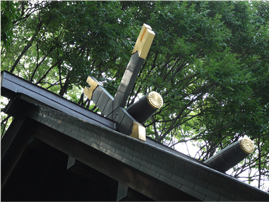



 Shinto is known as the indigenous religion of Japan that came from the daily life of the Japanese people. You will see Shinto events/ceremonies everywhere in Japanese people’s life. Major events/ceremonies are New Year’s visits to shrines, ceremonies to drive away evil spirits, the rite of passage for children aged 3, 5 and 7 yeas old, and wedding ceremonies, among others.
Shinto is known as the indigenous religion of Japan that came from the daily life of the Japanese people. You will see Shinto events/ceremonies everywhere in Japanese people’s life. Major events/ceremonies are New Year’s visits to shrines, ceremonies to drive away evil spirits, the rite of passage for children aged 3, 5 and 7 yeas old, and wedding ceremonies, among others.
In ancient times, Japanese ancestors lived life in harmony with nature. Humans are blessed by the power of nature, at the same time, we are threatened by nature. In ancient times, people felt the power of gods and goddess behind various natural phenomena. They were also grateful for the preciousness of life surrounded by nature, which continues from generation to generation. Thus, they believed that all life force that created everything was the power of Kami (gods and goddess). Thus, purity of nature, such as mountains, rocks, trees, and waterfalls contained a spirit, became objects of worship. In the course of time, people started to build a place for worship, which later became the shrine.
With the introduction of Buddhism and its rapid adoption by the court in the 6th century, native Japanese beliefs developed in various ways throughout Japan and those beliefs and spirits then started to be called “Shinto.”
Shinto's spirits are called “yaoyorozu no kami” , an expression literally meaning "eight million gods and goddess" because Japanese people believe that a countless number of Kami exist, like the nature of gods and goddesses which control natural phenomena related to the ocean, mountains, and wind, and other “kami” closely related to people’s lives. They also worship the spirits of ancestors and great figures who have made glorious achievements for their home towns as “Kami”. In Kojiki and Nihon shoki, the written historical records of the Nara Period, many Shinto practices and stories were recorded.
 There are many types of “Kami” such as Shinmei at Shinmei Shrine, Inari at Inari Shrine, Hachiman at Hachiman Shrine, and Tenjin at Tenjin Shrine. Japanese ancestors felt reverence for those “Kami” as local protective deity.
There are many types of “Kami” such as Shinmei at Shinmei Shrine, Inari at Inari Shrine, Hachiman at Hachiman Shrine, and Tenjin at Tenjin Shrine. Japanese ancestors felt reverence for those “Kami” as local protective deity.
Japanese "Matsuri" festivals have originated from the practice of Shinto belief. "Matsuri" festival represents Japanese people's life which is oriented around rice cultivation. There are distinctive festivals in each season; in spring, festivals to pray for a good harvest, in summer, festivals to pray for less damage from heavy rain or wind, and in autumn, festivals to cerebrate harvest. On the "Matsuri" festival day, along with the rituals, a parade of portable shrine and floats is also carried out to the shrine and many people come to see it. "Matsuri" festivals are not only held at shrines, but also held at each home. People pray for their family member's hearth or prosperity in front of the household altar, and such activity can also be considered as a small “Matsuri” festival.
The philosophy of Shinto is: to preserve nature like a sacred forest; to live in harmony with nature; to maintain peace in the local community through "Matsuri" festivals and strengthen the bond within the country; for prosperity of descendants; to pray for eternal prosperity of family, locals, and Japan. In addition, the Shinto religion values "purity" so the shrines are always kept "pure" and participants of "Matsuri" festivals are purified by visiting shrines. Japanese people's lives are deeply influenced by these philosophy and features.